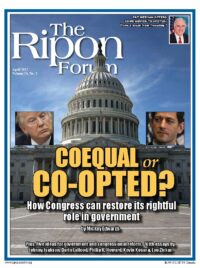
First off, most Americans dislike, distrust, and do not understand “the Congress,” and state legislatures fare little better. Lawmakers apparently do little save bicker, even as they win re-election after re-election. Legislatures are contentious places, where debates frequently turn nasty and lawmakers appear obligated to interest groups that help fund their campaigns. Increasingly, the Congress cannot address major societal problems as gridlock continually prevails.
According to many critics, the “problem” with an apparently unresponsive and dysfunctional Congress was simple: too many career politicians aligned with too many powerful interests. The answer? Limit the terms of lawmakers, so new blood would flow into the legislative body. Nationally, the U. S. Supreme Court has ruled unconstitutional attempts by the states to limit the terms of members of Congress. Thus, a constitutional amendment would be required to impose this policy. Given that already elected representatives and senators would have to provide two-thirds majorities in each chamber, this seems a most unlikely prospect.
Still, 15 states currently limit their state lawmakers to service of between six and 12 years, while two state legislatures have reversed such policies and courts have rejected term limits in another four. No state has adopted term limits since 2000, so there appears no rush to adopt this policy.
Nevertheless, most citizens favor term limits, with the most recent national survey (Rasmussen, October 2016) finding that 74 percent of Americans support them. During the 2016 campaign, 48 sitting members of Congress pledged to back a constitutional amendment to impose national term limits.
The question remains of what problem is addressed by limiting legislative terms. Historically, the Congressional Research Service reports that more than 90 percent of members of Congress run for reelection with a 90 percent success rate. Still, with two-year terms, congressional turnover is substantial; the average House member has served a bit less than ten years, and the average senator a bit more than a decade, figures that have been consistent over time.
Term limits weaken the legislative branch, at the expense of further empowering the executive and interest groups.
To be fair, term limits can infuse legislatures with “new blood,” and more citizens could serve in office under term-limit restrictions. Perhaps more importantly, veteran committee chairs and party leaders are less likely to dominate the process, and lawmakers would not develop cozy, long-term relationships with lobbyists. To be fair, perhaps there are some virtues.
So, what’s wrong with term limits?
First, term limits take the power to choose one’s representative out of the hands of the voters. If we want to vote an incumbent out of office — in either a primary or general election — we can.
Second, term limits weaken the legislative branch, at the expense of further empowering the executive and interest groups. Although most governors and the president are term-limited, the concentration of power within the executive allows them tremendous leverage in relations with the legislature. At the same time, lobbyists have no restrictions on their length of service and can exploit their expertise and contacts. In short, term limits offer advantages to the executive branch and to outside interests.
This is in part because, third, term limits weaken legislators within their own institution. In the states, inexperienced legislators must chair committees and serve as party leaders, almost before they learn where the capitol’s restrooms are located. To whom would Members of Congress turn, if not to outsiders like lobbyists? Historically, they have relied on professional staff members, but over the past 20 years, congressional staffing has fallen — in numbers, compensation, and expertise — as many senior staffers have joined the growing corps of lobbyists.
Fourth, term limits do not discourage political careers, as legislators focus on their next job, not their present one. In California, state representatives can serve for just three two-year terms, state senators for two four-year terms. They can see the end of their legislative careers almost before they are sworn in. By definition, they cannot build a career in the legislature, but this does not prevent them from making plans for a career that will move them from one job to another. What incentives do they have to serve their current constituents or their legislative institution?
Finally, term limits deplete the legislative talent pool. This occurs in at least two ways. Most obviously, experienced legislators must leave, just when they understand best how to work within a complex process. Perhaps more profoundly, however, term limits may well not even accomplish their primary goal: to encourage talented newcomers to serve in the legislature. Although there are more opportunities to win legislative office under term limits, the value of the office may decline to a point that qualified candidates simply avoid the rigors of contemporary campaigns that require intensive fund-raising and expose their families to a host of attacks.
In short, term limits address a modest “problem” (relatively low turnover) with a radical solution that weakens the legislative institution just when we should encourage thoughtful deliberation by veteran lawmakers who understand how representative democracy works.
Burdett Loomis is a political science professor at the University of Kansas.




